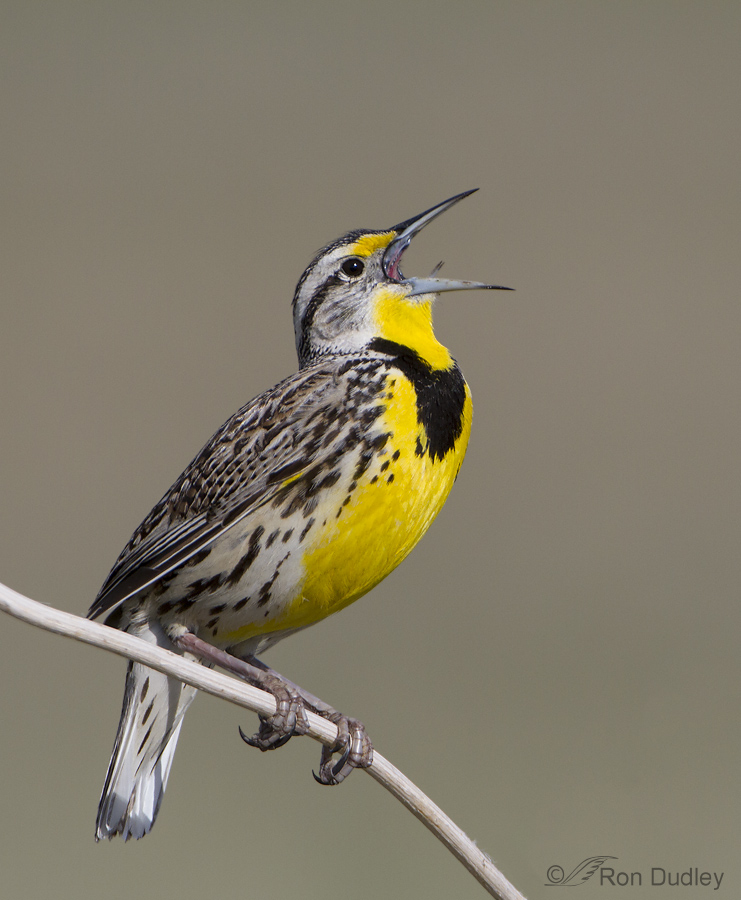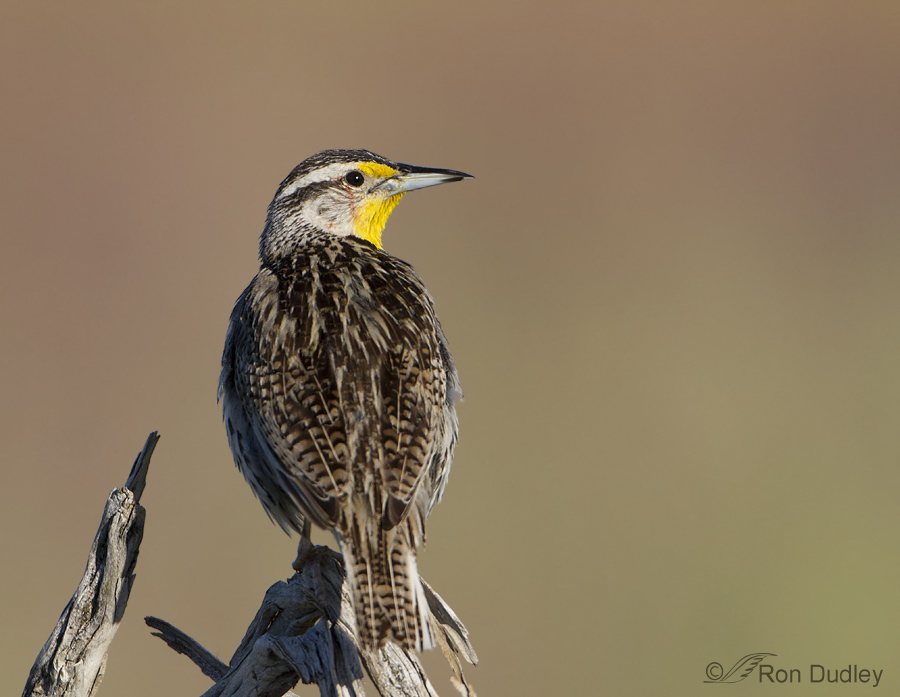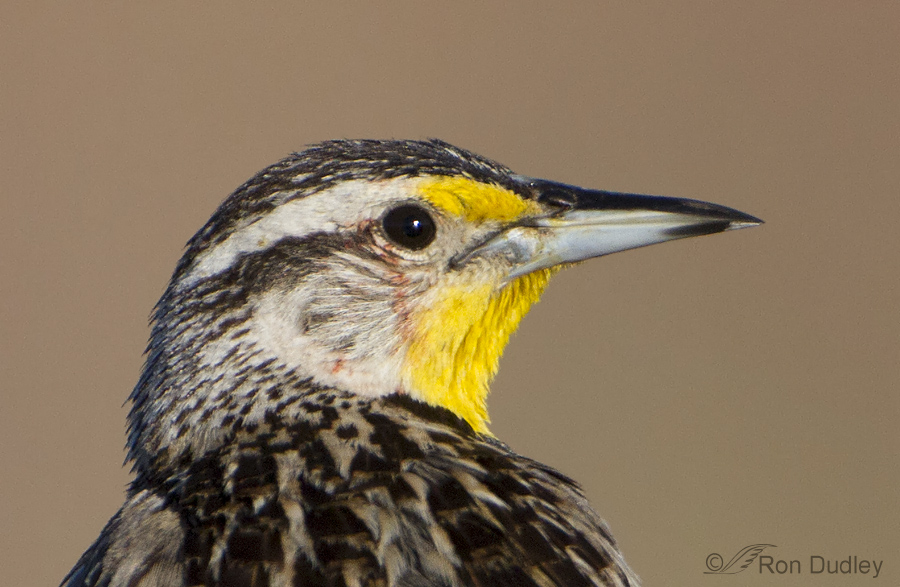The song of the meadowlark often stirs fond memories and thoughts of peaceful and melodious spring mornings. But for birds that song represents the tension of competition for territories and females – anything but tranquility.

1/2000, f/7.1, ISO 500, Canon 7D, 500 f/4, 1.4 tc, twig poking into frame removed, not baited, set up or called in
Males in particular are marathon singers. Their primary song is complex and melodious but each bird has many song types – averaging 7 but up to 12. Song intensity increases as territorial males arrive in the spring and peaks just before the late-arriving females show up but since they raise several broods per breeding season their territorial songs can be heard throughout the summer.

1/2500, f/6.3, ISO 640, Canon 7D, 500 f/4, 1.4 tc, not baited, set up or called in
Males are aggressive in defending their territories and when evicting trespassers they pursue them in flight until they’ve been chased beyond the territorial boundary. The chase can last as long as 3 minutes without interruption if the invader is reluctant to leave and chases can occur as often as once per minute early in the season.
This apparent male has an injury behind its right eye, as evidenced by the blood that can be seen on the side of its face. The image was taken during the height of the breeding season (May 21 of last year) and I strongly suspect it to be a battle injury inflicted by the long and very sharp beak of a rival.

A tight crop of the previous image reveals more wound detail – an apparent puncture that just missed the eye. This bird was lucky not to have lost its eye – a reminder of one of the reasons we see so many eye injuries in birds and why they have nictitating membranes (nictitans) for eye protection.
- “Body contact and fighting between males, though uncommon, can be quite severe with much thrashing of wings, jabbing of bills, and clawing. One combat lasted for 3 min, during which the 2 males grappled so intently they tumbled awkwardly about on ground. On another occasion wounds had obviously been inflicted on malar region of one trespasser; when examined in the hand 10 wk later, the wounds had healed but were featherless” – Birds of North America Online
Whenever I see and hear Western Meadowlarks singing I have to remind myself of the tension it represents. For anyone who needs a dose of spring this morning here’s a video clip of one of these birds singing its little heart out.
Ron


A friend of mine (Lakota) claims he can understand what they (meadowlarks) are “saying”. I wonder! I used to “understand” a little “crow”. I could tell when a cat or dog came into the yard,(different sounds), when someone put garbage put, when my husband’s truck was approaching the neighborhood, when the kids’ bus was approaching , when three people had gone in to a house and only two came out, and and a couple of other “phrases”. It wasn’t hard to learn these as every thought came right out of his big, fat beak!!! To this day, I cringe when I hear a young crow calling and squalling…especially if there’s a cat in the yard. I find myself looking around wildly for the offending feline!
I envy your experience with that crow, Patty. I’d love to have that kind of “relationship” with any wild bird but especially a corvid because they’re so intelligent.
An interesting point you raise, Ron … which leads me to a dilemma that wild bird rehabilitators often face. When an adult bird comes into care during breeding season or needs to be held for care into breeding season, the question of where to release it arises. I once released a male robin back to where he was found (and he hadn’t been in care that long), only to discover that his mate had apparently replaced him and the ensuing battle was bad, indeed: both having a vested interest in the site. The altercation went out of my sight but it was a wake up call for me – although there is no easy answer, unless you can spend time in the field, know where the territory is, and observe. I’ve also seen some amazing reunions, on the other hand – a female redtailed hawk that came to me in February and wasn’t ready for release until mid-April, well into breeding season. Because we get a lot of in-migration into our area during the winter, and one never knows if an adult hawk coming into care in winter is a resident or a migrant, I took the risk of releasing this bird back where she was found (our typical policy with adults). She flew off to a tree across a couple of hills and IMMEDIATELY another bird came flying in, screaming. Before I could say “oh, no!” the incoming adult started doing courtships dives, she met him in mid-air, and they immediately returned to a branch and mated! In my imagination, I could hear him saying ‘Where the heck have you BEEN, woman? We need to get busy!” Biologists always wonder, with the monogamous birds, how much is mate-fidelity and how much is site-fidelity – but that male had had plenty of time to replace her and it’s not like there aren’t plenty of redtails around. In fact, come to think of it, I don’t think I’ve ever had a redtail come in with injuries that seemed to imply a territorial dispute – whereas that happens WAY too often with bald eagles, resulting in horrendous wounds.
Interesting observations Louise and what fascinating tales about the Robins and the Red-tails! With all your experience you always have such valuable input for these situations. I appreciate your comments so much and I know that others do too (in fact just this morning I heard just that about you in a private email from another follower of my blog). Thank you!
Love that song. Thank you.
And the reminder that ‘pecking order’ isn’t a tired and bloodless cliche.
“And the reminder that ‘pecking order’ isn’t a tired and bloodless cliche.”
Very well said, Elephant’s Child.
What a beautiful capture of this gorgeous creature!!!
Thanks very much, Lois.
Excellent shots Ron, much appreciate the images.
Thank you, Dick.
I love the song of this bird… spent so many moments just listening to it. Thank you!
Me too, Rima. Used to sit outside in Montana just to listen to them (when the wind wasn’t blowing..)